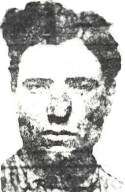Joseph Ardizzone
| Joseph Ardizzone | |
|---|---|
|
Joseph Ardizzone's mug shot taken in 1914. | |
| Born |
Giuseppe Ernesto Ardizzone November 19, 1884 Piana dei Greci, Sicily |
| Died |
October 15, 1931 (aged 46) California |
| Cause of death | Murder |
| Nationality | Italian |
| Other names | Iron Man |
| Ethnicity | Arbrëshë |
| Known for | Mob Activity |
| Religion | Roman Catholicism |
| Spouse(s) | Elsie A. Ardizzone[1] |
| Parent(s) | Antonino Ardizzone (father) |
| Relatives |
George Ardizzone[2] (brother) Frank Ardizzone (brother) |
Joseph "Iron Man" Ardizzone (November 19, 1884 – October 15, 1931) was an early Los Angeles mobster, who became the first Boss of the Los Angeles crime family. He was involved in a long-standing feud with the Matranga family, and became the only Los Angeles boss to be murdered by his own men. He once claimed to have killed 30 men.[3]
Early life
Born Giuseppe Ernesto Ardizzone in Piana dei Greci (today Piana degli Albanesi), in the Province of Palermo, Sicily, to Antonino Ardizzone on November 19, 1884. Some of his maternal ancestors were descended from Albanians who fought the Ottomans during the 15th century. The Albanians were given land grants in what later became Italy, and with Piana di Greci being one of the larger Albanian communities. The Ardizzones were related to several other families and they would maintain contact in America. Those families included the Cuccias and the Matrangas.[4]
Early years in America
The Ardizzone family came to America at different times. Antonino came in the later 19th century, landing in Louisiana then taking the train to southern California. He became a wealthy farmer and wine maker. His other children, including Stefano and Francesco also moved to the Los Angeles area. Giuseppe was one of the last to arrive.
Matranga feud

For reasons uncertain Giuseppe, who Americanized his name to Joseph, became involved in a dispute with the Matrangas who lived in Los Angeles. They were distant cousins from Piana dei Greci. In what he later called an act of self-defense, Joseph shot and killed a Matranga ally named George Maisano in 1906.[5] He then fled California and hid in different states.
He eventually returned and was arrested, but the charges against him were dropped. He then married a young girl named Elsa who was the daughter of a German neighbor in the city of Sunland, where they lived at that time. Shortly after that their home was burned down by arsonists.[6]
Later life
While it is uncertain when Ardizzone became a member of the Mafia, or even if his immediate family were members, he was in a leadership position in the early 1920s. Upon the resignation of Rosario DeSimone for unknown reasons, he became the next chief of the Los Angeles crime family.
During his time as boss Prohibition was active and many, if not most, Mafiosi were involved in bootlegging. The Los Angeles Family was certainly active during this time period.
In 1931, when the Castellammarese War between Joseph Masseria and Salvatore Maranzano was taking place, the Los Angeles crime family may have supported Maranzano. Nick Gentile notes in his memoirs that during a conference Maranzano was backed by two men from California. Joseph Bonanno {died 2002} and his son Salvatore Bonanno {died 2008} wrote of several close associates in the Los Angeles area, such as Jimmy Costa (from Castellammare del Golfo), Nick Guastella, Frank Bompensiero and Tony Mirabile.
It was also during this time that a faction developed that opposed Ardizzone. In early 1931 he was driving with his friend Jimmy Basile when gunmen drove by and shot at them. Basile was killed and Ardizzone wounded. Ardizzone managed to be taken to the house of Leon DeSimone, the physician son of former L.A. don Rosario DeSimone. He was treated and sent to a hospital. A second attempt was made on his life in the hospital, so his family came to act as bodyguards. Underworld sources indicated that he agreed to retire after these incidents.
The opposing faction apparently did not believe Ardizzone, and on October 15, 1931, while on his way to a cousin's house in Etiwanda, driving a 1930 Ford Coupe SRW7653 and carrying a .41 caliber Colt revolver No.323 he "disappeared". An intense search followed, but his body was never found. After seven years Ardizzone's wife had him declared legally dead.[7]
Notes
- ↑ "TRUSTEE ASKED FOR ARDIZZONE", Los Angeles Times, February 8, 1932, p. 1, retrieved September 16, 2009
- ↑ "Fire Destroys Missing Man's Brother's House", Los Angeles Times, April 7, 1932, pp. A3
- ↑ http://books.google.com/books?ei=IKCVTIGzC82xngfmt6G4CA&ct=result&id=6IvaAAAAMAAJ&dq=domenico+di+ciolla&q=di+ciolla#search_anchor
- ↑ World War I Draft Registration Card for Joseph Ardizzone.
- ↑ "California Digital Newspaper Collection | Los Angeles Herald September 26, 1906". cdnc.ucr.edu. Retrieved June 3, 2015.
- ↑ Tiernan, Mary Lee. He Never Came Home. The History of Sunland, California, Vol. 5. Snoops Desktop Publishing, 1999.
- ↑ State of California, Final report of the Special Crime Study Commission on Organized Crime (Sacramento, 1953).
References
- California Assembly, Interim Committee on Judiciary. Organized Crime in California—Report of the Subcommittee on Rackets. Sacramento, 1959.
- Gentile, Nick, with Felice Chilanti. Vita di Capomafia. Rome: Editori Riuniti, 1963.
- State of California. Final report of the Special Crime Study Commission on Organized Crime. Sacramento, 1953.
- Warner, Richard N. "The First Mafia Boss of Los Angeles? The Mystery of Vito Di Giorgio, 1880–1922." On The Spot Journal (Summer 2008), 46-54.
| Business positions | ||
|---|---|---|
| Preceded by Rosario DeSimone (1922–1925) |
Los Angeles crime family Boss 1925–1931 |
Succeeded by Jack Dragna (1931–1956) |
|
| ||||||||||||||||||||||||||||||||||||||||||||||||||||
